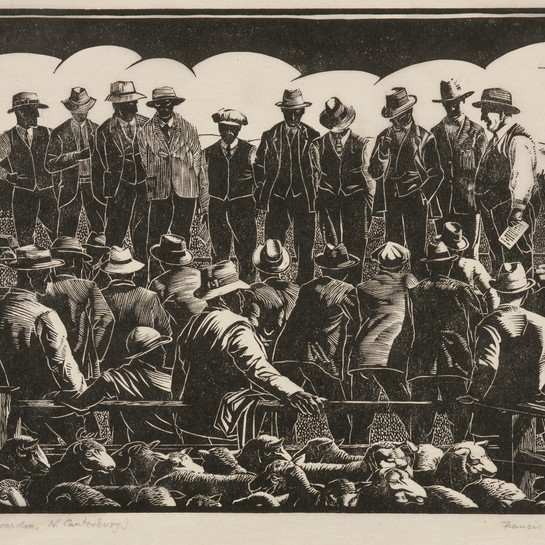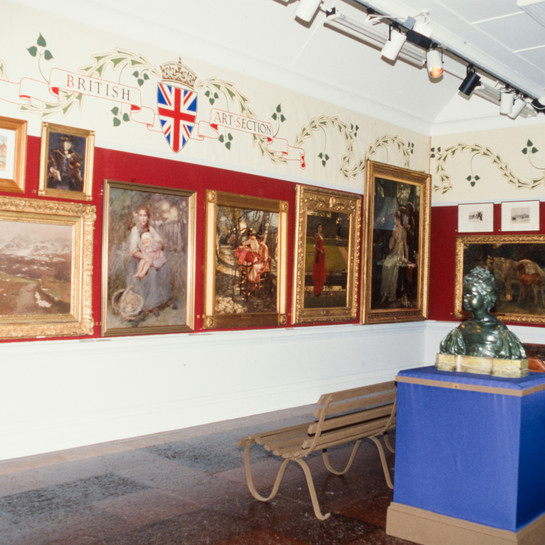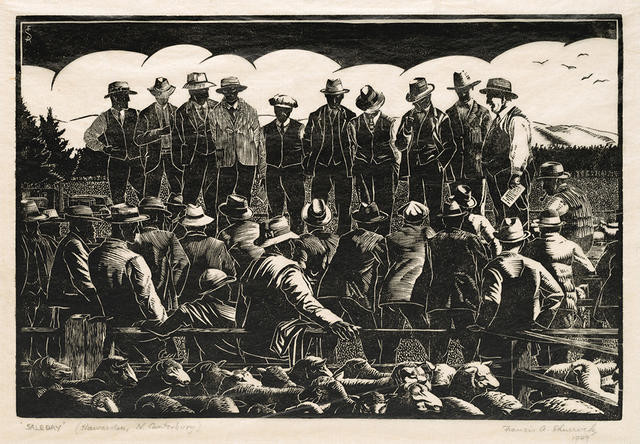Francis A. Shurrock
Aotearoa New Zealand / British, b.1887, d.1977
Sale Day Hawarden, N. Canterbury
- 1929
- Linocut
- Presented by Mr F A Shurrock 1960
- 220 x 318mm
- 69/460
- View on google maps
Tags: animals, birds (animals), clouds, farmers, fences, hats, markets (events), men (male humans), monochrome, people (agents), sheep, trade (function), trees
Like Roland Hipkins, Robert Field and William Allen, the sculptor Francis Shurrock studied at the Royal College of Art in London and immigrated to Aotearoa under the La Trobe scheme to take up a teaching position at one of the country’s art schools. Francis, or Shurrie as his students fondly called him, taught at the Canterbury College School of Art in Ōtautahi Christchurch, where he offered a contemporary, modern outlook on art that was in contrast to the conservative atmosphere of the school at that time. Francis owned a large collection of ukiyo-e Japanese woodblock prints, which he made freely available to his students and friends. He began making linocuts in the late 1920s and wood-engravings in the early 1930s, encouraging many of his students to use these mediums in their practice.
Ink on Paper: Aotearoa New Zealand Printmakers of the Modern Era, 11 February – 28 May 2023
Exhibition History
Beneath the ranges, 18 February – 23 October 2017
Trained at the Royal College of Art in London, Francis Shurrock arrived in New Zealand in 1924 to teach sculptural modelling at the Canterbury College School of Art (now the University of Canterbury). Shurrock was a much-liked and inspiring presence at the College for twenty-five years, and exerted a considerable influence on a generation of students. Among the best-known of these were Russell Clark, Olivia Spencer Bower, Rita Angus, Bill Sutton, Toss Woollaston and Juliet Peter – all of whom feature in this exhibition. This linocut, believed to have been produced as a demonstration piece for Shurrock’s printmaking classes, reflects his often expressed belief in the importance of connecting art to everyday life.
At one time in the North Canterbury rural community of Hawarden an important weekly event was when the farmers of the region brought their livestock to be auctioned by the local stock agent. Francis Shurrock has captured the sense of everyday reality at the sale yards, with the absorbed farmers and the waiting sheep. Organised in layers, almost like a sculptural basrelief, Shurrock has achieved not only a clever demarcation of forms and volumes, but also a beautifully balanced composition. Born in England, Shurrock received a Royal Exhibition Scholarship in 1909, which enabled him to study at the Royal College of Art, London. He came to New Zealand in 1924 to teach at the Canterbury College School of Art. He held the position until 1948. Shurrock exhibited with the Canterbury Society of Arts and served on the society’s council. He also exhibited with The Group in Christchurch and with the Royal Academy, London. After his retirement he worked on private sculptural projects.
(Label date unknown)





